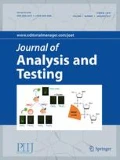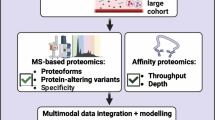Abstract
Metabolomics is largely employed in numerous biomedical research fields, such as the study of the underlying pathology of diseases, discovery of diagnostic biomarkers, or drug development. Nowadays, the main challenge is to obtain comprehensive and unbiased metabolomic profiles due to the huge complexity, heterogeneity, and dynamism of the metabolome. To this end, mass spectrometry represents a very interesting analytical platform, since the complexity of metabolome may be overcome through the use of different orthogonal separation techniques, including liquid chromatography, gas chromatography, and capillary electrophoresis. Alternatively, direct mass spectrometry analysis has been postulated as a complementary choice to hyphenated approaches. This technique exhibits several advantages such as the ability for high-throughput screening, fast analysis, and wide metabolomic coverage, since there is not exclusion of compounds due to the separation device. The present work explores the utility of metabolomics based on direct infusion mass spectrometry for analyzing blood samples. The most important analytical concerns to be considered are discussed, including sample handling, comprehensive fingerprinting, as well as subsequent identification of metabolites, and global characterization of metabolomic profiles. To conclude, a brief review on the application of these metabolomic platforms in Alzheimer’s disease research is also provided.

(Reprinted from González-Domínguez et al. [11] with permission from Springer)

Similar content being viewed by others
Change history
09 October 2017
A Correction to this paper has been published: https://doi.org/10.1007/s41664-017-0041-5
References
Emwas AHM, Salek RM, Griffin JL, Merzaban J. NMR-based metabolomics in human disease diagnosis: applications, limitations, and recommendations. Metabolomics. 2013;9:1048–72.
Dettmer K, Aronov PA, Hammock BD. Mass spectrometry-based metabolomics. Mass Spectrom Rev. 2007;26:51–78.
Kuehnbaum NL, Britz-McKibbin P. New advances in separation science for metabolomics: resolving chemical diversity in a post-genomic era. Chem Rev. 2013;113:2437–68.
Barbas C, Moraes EP, Villaseñor A. Capillary electrophoresis as a metabolomics tool for non-targeted fingerprinting of biological samples. J Pharm Biomed Anal. 2011;55:823–31.
González-Domínguez R, Sayago A, Fernández-Recamales A. Direct infusion mass spectrometry for metabolomic phenotyping of diseases. Bioanalysis. 2017;9:131–48.
González-Domínguez R, Sayago A, Fernández-Recamales A. Metabolomics in Alzheimer’s disease: the need of complementary analytical platforms for the identification of biomarkers to unravel the underlying pathology. J Chromatogr B. 2017 (in press).
Draper J, Lloyd AJ, Goodacre R, Beckmann M. Flow infusion electrospray ionisation mass spectrometry for high throughput, non-targeted metabolite fingerprinting: a review. Metabolomics. 2013;9:S4–29.
Li N, peng Song Y, Tang H, Wang Y. Recent developments in sample preparation and data pre-treatment in metabonomics research. Arch Biochem Biophys. 2016;589:4–9.
Nordström A, Want E, Northen T, Lehtiö J, Siuzdak G. Multiple ionization mass spectrometry strategy used to reveal the complexity of metabolomics. Anal Chem. 2008;80:421–9.
Blennow K, de Leon MJ, Zetterberg H. Alzheimer’s disease. Lancet. 2006;368:387–403.
Maccioni RB, Muñoz JP, Barbeito L. The molecular bases of Alzheimer’s disease and other neurodegenerative disorders. Arch Med Res. 2001;32:367–81.
González-Domínguez R, García-Barrera T, Gómez-Ariza JL. Characterization of metal profiles in serum during the progression of Alzheimer’s disease. Metallomics. 2014;9:292–300.
Ibáñez C, Simó C, Cifuentes A. Metabolomics in Alzheimer’s disease research. Electrophoresis. 2013;34:2799–811.
Patel S, Shah RJ, Coleman P, Sabbagh M. Potential peripheral biomarkers for the diagnosis of Alzheimer’s disease. Int J Alzheimers Dis. 2011;2011:572495.
González-Domínguez R, García-Barrera T, Gómez-Ariza JL. Metabolomic study of lipids in serum for biomarker discovery in Alzheimer’s disease using direct infusion mass spectrometry. J Pharm Biomed Anal. 2014;98:321–6.
González-Domínguez R, García-Barrera T, Gómez-Ariza JL. Using direct infusion mass spectrometry for serum metabolomics in Alzheimer’s disease. Anal Bioanal Chem. 2014;406:7137–48.
Beckmann M, Parker D, Enot DP, Duval E, Draper J. High-throughput, nontargeted metabolite fingerprinting using nominal mass flow injection electrospray mass spectrometry. Nat Protoc. 2008;3:486–504.
Sumner LW, Amberg A, Barrett D, Beale MH, Beger R, Daykin CA, Fan TWM, Fiehn O, Goodacre R, Griffin JL, Hankemeier T, Hardy N, Harnly J, Higashi R, Kopka J, Lane AN, Lindon JC, Marriott P, Nicholls AW, Reily MD, Thaden JJ, Viant MR. Proposed minimum reporting standards for chemical analysis: chemical Analysis Working Group (CAWG) Metabolomics Standards Initiative (MSI). Metabolomics. 2007;3:211–21.
Vinaixa M, Schymanski EL, Neumann S, Navarro M, Salek RM, Yanes O. Mass spectral databases for LC/MS- and GC/MS-based metabolomics: state of the field and future prospects. Trends Anal Chem. 2016;78:23–35.
Psychogios N, Hau DD, Peng J, Guo AC, Mandal R, Bouatra S, Sinelnikov I, Krishnamurthy R, Eisner R, Gautam B, Young N, Xia J, Knox C, Dong E, Huang P, Hollander Z, Pedersen TL, Smith SR, Bamforth F, Greiner R, McManus B, Newman JW, Goodfriend T, Wishart DS. The human serum metabolome. PLoS ONE. 2011;6:e16957.
Moco S, Bino RJ, De Vos RCH, Vervoort J. Metabolomics technologies and metabolite identification. Trends Anal Chem. 2007;26:855–66.
Murphy RC, Barkley RM, Berry KZ, Hankin J, Harrison K, Johnson C, Krank J, McAnoy A, Uhlson C, Zarini S. Electrospray ionization and tandem mass spectrometry of eicosanoids. Anal Biochem. 2005;346:1–42.
Vernez L, Hopfgartner G, Wenk M, Krahenbuhl S. Determination of carnitine and acylcarnitines in urine by high-performance liquid chromatography–electrospray ionization ion trap tandem mass spectrometry. J Chromatogr A. 2003;984:203–13.
Divito EB, Davic AP, Johnson ME, Cascio M. Electrospray ionization and collision induced dissociation mass spectrometry of primary fatty acid amides. Anal Chem. 2012;84:2388–94.
Murphy RC, Leiker TJ, Barkley RM. Glycerolipid and cholesterol ester analyses in biological samples by mass spectrometry. Biochim Biophys Acta. 2011;1811:776–83.
González-Domínguez R, García-Barrera T, Gómez-Ariza JL. Iberian ham typification by direct infusion electrospray and photospray ionization mass spectrometry fingerprinting. Rapid Commun Mass Spectrom. 2012;26:835–44.
Pulfer M, Murphy RC. Electrospray mass spectrometry of phospholipids. Mass Spectrom Rev. 2003;22:332–64.
Wang C, Xie S, Yang J, Yang Q, Xu G. Structural identification of human blood phospholipids using liquid chromatography/quadrupole-linear ion trap mass spectrometry. Anal Chim Acta. 2004;525:1–10.
González-Domínguez R, García-Barrera T, Gómez-Ariza JL. Combination of metabolomic and phospholipid-profiling approaches for the study of Alzheimer’s disease. J Proteom. 2014;104:37–47.
Haynes CA, Allegood JC, Park H, Sullards MC. Sphingolipidomics: methods for the comprehensive analysis of sphingolipids. J Chromatogr B. 2009;877:2696–708.
Liebisch G, Binder M, Schifferer R, Langmann T, Schulz B, Schmitz G. High throughput quantification of cholesterol and cholesteryl ester by electrospray ionization tandem mass spectrometry (ESI-MS/MS). Biochim Biophys Acta. 2006;1761:121–8.
Qiao X, Ye M, Liu CF, Yang WZ, Miao WJ, Dong J, Guo DA. A tandem mass spectrometric study of bile acids: interpretation of fragmentation pathways and differentiation of steroid isomers. Steroids. 2012;77:204–11.
González-Domínguez R, García-Barrera T, Gómez-Ariza JL. Metabolomic approach to Alzheimer’s disease diagnosis based on mass spectrometry. Chem Pap. 2012;66:829–35.
González-Domínguez R, García-Barrera T, Vitorica J, Gómez-Ariza JL. Application of metabolomics based on direct mass spectrometry analysis for the elucidation of altered metabolic pathways in serum from the APP/PS1 transgenic model of Alzheimer’s disease. J Pharm Biomed Anal. 2015;107:378–85.
González-Domínguez R, García-Barrera T, Vitorica J, Gómez-Ariza JL. Metabolomic research on the role of interleukin-4 in Alzheimer’s disease. Metabolomics. 2015;11:1175–83.
González-Domínguez R, Rupérez FJ, García-Barrera T, Barbas C, Gómez-Ariza JL. Metabolomic-driven elucidation of pathological mechanisms associated with Alzheimer’s disease and mild cognitive impairment. Curr Alzheimer Res. 2016;13:641–53.
González-Domínguez R, García-Barrera T, Vitorica J, Gómez-Ariza JL. Deciphering metabolic abnormalities associated with Alzheimer’s disease in the APP/PS1 mouse model using integrated metabolomic approaches. Biochimie. 2015;110:119–28.
González-Domínguez R, García-Barrera T, Gómez-Ariza JL. Metabolite profiling for the identification of altered metabolic pathways in Alzheimer’s disease. J Pharm Biomed Anal. 2015;107:75–81.
González-Domínguez R, García A, García-Barrera T, Barbas C, Gómez-Ariza JL. Metabolomic profiling of serum in the progression of Alzheimer’s disease by capillary electrophoresis–mass spectrometry. Electrophoresis. 2014;35:3321–30.
González-Domínguez R, Castilla-Quintero R, García-Barrera T, Gómez-Ariza JL. Development of a metabolomic approach based on urine samples and direct infusion mass spectrometry. Anal Biochem. 2014;465:20–7.
González-Domínguez R, García-Barrera T, Vitorica J, Gómez-Ariza JL. Metabolomic screening of regional brain alterations in the APP/PS1 transgenic model of Alzheimer’s disease by direct infusion mass spectrometry. J Pharm Biomed Anal. 2015;102:425–35.
González-Domínguez R, García-Barrera T, Vitorica J, Gómez-Ariza JL. High throughput multi-organ metabolomics in the APP/PS1 mouse model of Alzheimer’s disease. Electrophoresis. 2015;36:2237–49.
Gago-Tinoco A, González-Domínguez R, García-Barrera T, Blasco-Moreno J, Bebianno MJ, Gómez-Ariza JL. Metabolic signatures associated with environmental pollution by metals in Doñana National Park using P. clarkii as bioindicator. Environ Sci Pollut Res Int. 2014;21:13315–23.
Lin S, Liu H, Kanawati B, Liu L, Dong J, Li M, Huang J, Schmitt-Kopplin P, Cai Z. Hippocampal metabolomics using ultrahigh-resolution mass spectrometry reveals neuroinflammation from Alzheimer’s disease in CRND8 mice. Anal Bioanal Chem. 2013;405:5105–17.
Lin S, Kanawati B, Liu L, Witting M, Li M, Huang J, Schmitt-Kopplin P, Cai Z. Ultrahigh resolution mass spectrometry-based metabolic characterization reveals cerebellum as a disturbed region in two animal models. Talanta. 2014;118:45–53.
González-Domínguez R, García-Barrera T, Gómez-Ariza JL. Application of a novel metabolomics approach based on atmospheric pressure photoionization mass spectrometry using flow injection analysis for the study of Alzheimer’s disease. Talanta. 2015;131:480–9.
Wood PL, Locke VA, Herling P, Passaro A, Vigna GB, Volpato S, Valacchi G, Cervellati C, Zuliani G. Targeted lipidomics distinguishes patient subgroups in mild cognitive impairment (MCI) and late onset Alzheimer’s disease (LOAD). BBA Clin. 2016;5:25–8.
Han X, Holtzman DM, McKeel DW Jr. Plasmalogen deficiency in early Alzheimer’s disease subjects and in animal models: molecular characterization using electrospray ionization mass spectrometry. J Neurochem. 2001;77:1168–80.
Han X, Holtzman DM, McKeel DW Jr, Kelley J, Morris JC. Substantial sulfatide deficiency and ceramide elevation in very early Alzheimer’s disease: potential role in disease pathogenesis. J Neurochem. 2002;82:809–18.
Cheng H, Zhou Y, Holtzman DM, Han X. Apolipoprotein E mediates sulfatide depletion in animal models of Alzheimer’s disease. Neurobiol Aging. 2010;31:1188–96.
Cheng H, Wang M, Li JL, Cairns NJ, Han X. Specific changes of sulfatide levels in individuals with pre-clinical Alzheimer’s disease: an early event in disease pathogenesis. J Neurochem. 2013;127:733–8.
Han X, Rozen S, Boyle SH, Hellegers C, Cheng H, Burke JR, Welsh-Bohmer KA, Doraiswamy PM, Kaddurah-Daouk R. Metabolomics in early Alzheimer’s disease: identification of altered plasma sphingolipidome using shotgun lipidomics. PLoS ONE. 2011;6:e21643.
Author information
Authors and Affiliations
Corresponding author
Additional information
A correction to this article is available online at https://doi.org/10.1007/s41664-017-0041-5.
About this article
Cite this article
González-Domínguez, R. Metabolomic Fingerprinting of Blood Samples by Direct Infusion Mass Spectrometry: Application in Alzheimer’s Disease Research. J. Anal. Test. 1, 17 (2017). https://doi.org/10.1007/s41664-017-0018-4
Received:
Accepted:
Published:
DOI: https://doi.org/10.1007/s41664-017-0018-4




